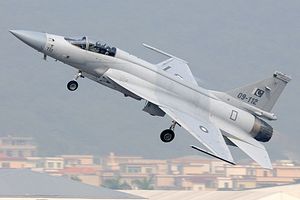The Pakistan Air Force (PAF) operates a total of 70 Pakistan Aeronautical Complex/Chengdu Aerospace Corporation (PAC/CAC) JF-17 Thunder fighter jets, the National Assembly Standing Committee on Defense Production revealed in Islamabad on December 7, according to local media reports.
The PAF now fields about an equal number of JF-17 and U.S.-made F-16 multirole fighter aircraft of all variants. (After U.S. lawmakers stalled financing for an additional eight F-16C/D Block-52 fighter aircraft, Pakistan is now mulling the purchase of eight used F-16s from the Royal Jordanian Air Force.)
The JF-17, first inducted into the PAF in 2011, is a lightweight, single-engine, multirole combat aircraft, powered by a Russian-designed-but-Chinese-built Klimov RD-93 (a RD-33 derivative) turbofan, capable of reaching a top speed of Mach 1.6. The aircraft allegedly has an operational range of around 1,200 kilometers (745 miles).
In total, the PAF plans to acquire 150 JF-17s over the next years divided into three production blocks: Block-I, Block II, and Block-III. So far, the PAF has only received Block-I and Block-II variants of the aircraft. 50 out of the 70 JF-17 in service are of the Block-I variant. The PAF last inducted 16 Block-II JF-17s in April.
As I noted elsewhere, according to the chief of air staff, Air Chief Marshal Sohail Aman, Pakistan achieved its goal of producing 16 JF-17 Thunder aircraft in 2015 and wants to produce a total number of 24 Block-II JF-17 aircraft by the end of 2016. Next to carrying a heavier weapons payload, Block-II variants feature a new air-to-air refueling probe, an enhanced oxygen system, and an improved electronic countermeasures system, among other things.
Pakistan produces 58 percent of the airframe and China 42 percent respectively. Islamabad has the capacity to assemble up to 25 JF-17s per year without Beijing’s technical assistance. However, as I noted in April 2015, according to Chinese and Pakistani media reports, China agreed to deliver 110 JF-17s to Pakistan in fly-away condition due to Pakistan’s still limited aircraft manufacturing capacity.
The JF-17 was originally developed to to replace the PAF’s aging fleet of Dassault Mirage III/5 fighter jets by 2o20. “Pakistan is looking to replace 190 aircraft—primarily Chengdu F-7 and Dassault Mirage III/5 fighter jets—by 2020 presumably with a mixture of F-16 and JF-17 aircraft. Pakistan, however, is also allegedly in talks with Russia over the purchase of Su-35 multi-role fighters,” I reported in April (See: “China and Pakistan Air Forces Launch Joint Training Exercise”).
China and Pakistan are also developing a combat-capable two-seat trainer variant of the JF-17, which likely will make its maiden flight in the coming weeks.
































